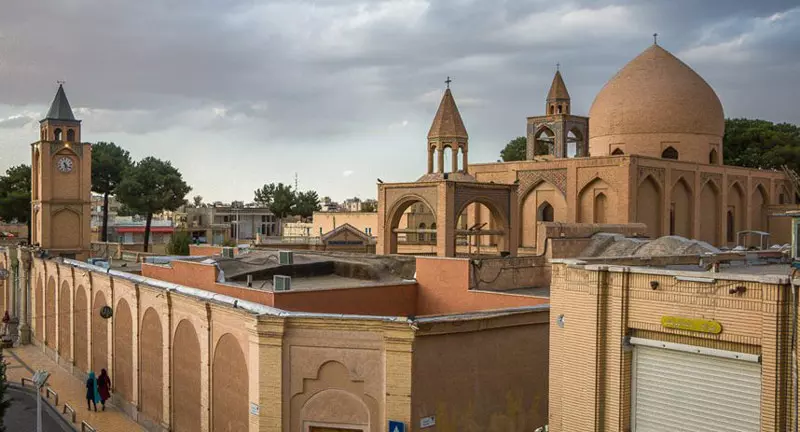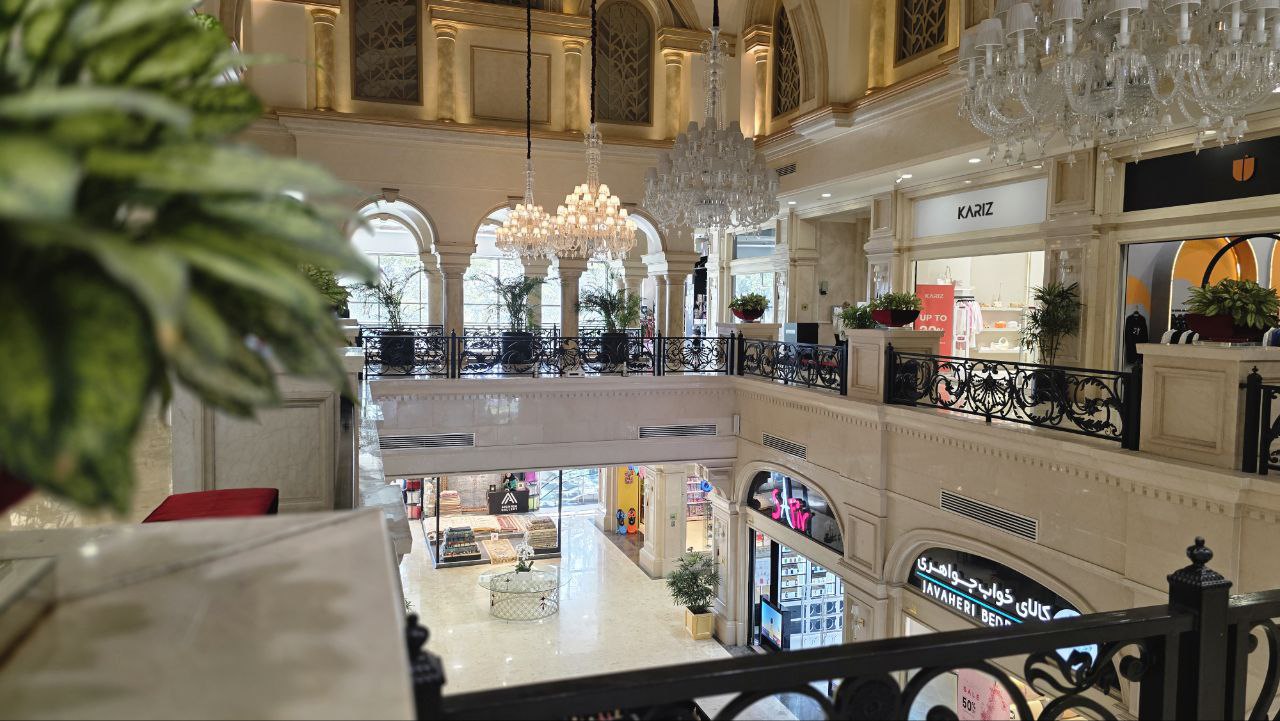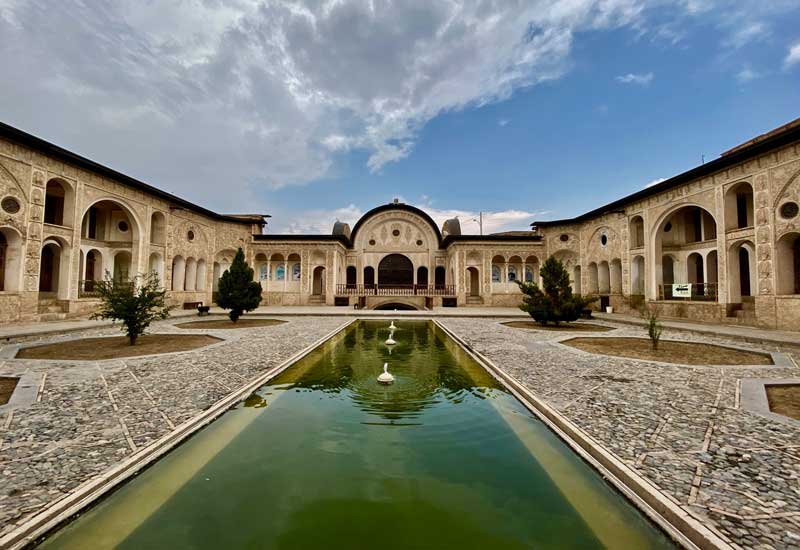vank cathedral : A Jewel of Isfahan
Vank Cathedral, like a shining gem, adorns the heart of Isfahan. Its simple yet beautiful architecture, unique paintings, and historical significance distinguish it from other churches in Iran. Over the years, Vank Cathedral has undergone evolutionary changes, with various sections added to its compound and building, further enhancing its importance.
Today, Vank Cathedral still holds a powerful position among the Armenian community in Isfahan and is recognized worldwide. When visiting this historical attraction in Isfahan, you can spend hours admiring the beauty of its different sections.

Everything You Need to Know About Vank Cathedral:
About Vank Cathedral
History of Vank Cathedral
Visiting Hours and Address of Vank Cathedral
Architecture of Vank Cathedral
Sections of Vank Cathedral
About Vank Cathedral
Vank Cathedral stands as one of the largest historical and religious attractions in the Jolfa neighborhood and among the must-see places in Isfahan. Constructed by Armenian immigrants during the Safavid era under Shah Abbas, the initial form of Vank Cathedral differed from its present structure. Initially serving solely as a religious institution for Christians, today, most attention is drawn to its historical significance and cultural appeal.
Regarded as Iran’s largest and most famous church, Vank Cathedral remains the central Armenian cathedral in Isfahan. Also known as “Amna Perkich,” it is one of the thirteen remaining churches in the Jolfa neighborhood of Isfahan dating back to the 17th century AD. “Vank” translates to “monastery” in Armenian. Over time, Vank Cathedral not only retained its religious significance among the people of Isfahan, particularly the Armenian residents of the Jolfa neighborhood, but also transformed into an administrative center and a venue for social events. In the subsequent years, Iran and the Middle East’s first printing press with a printing machine was established in the courtyard of this cathedral.

One of Vank Cathedral’s most captivating features, attracting everyone’s attention, is the prominent influence of artistic masterpieces within its walls. Throughout Vank Cathedral, numerous works by renowned artists catch the eye. Elegant and magnificent architecture, beautiful sculptures, colorful frescoes, paintings, and historical artworks have added value to Vank Cathedral. In the courtyard of Vank Cathedral, the remains of some Armenian dignitaries are also interred.
Vank Cathedral today comprises various sections, requiring ample time for a visit to this historical edifice. This cathedral was registered on the National Heritage List of Iran on January 4, 1932. In the following sections of this article, we will delve into the history, architecture, artistic attractions, and different sections of Vank Cathedral.
History of Vank Cathedral
The Jolfa neighborhood in Isfahan, where Vank Cathedral is situated, has been the residence of Armenian immigrants in Iran since ancient times. During the Safavid era, Shah Abbas I ordered a retreat from the war with the Ottomans. Along the return route, the Iranian army passed through Armenia. By Shah Abbas’s decree, significant portions of the route were destroyed to prevent the Ottoman advance, putting the Armenian population at risk of mass slaughter. Therefore, Shah Abbas decided to bring the Armenians to Iran and settle them there. At the end of this long journey, Shah Abbas and his troops, along with the Armenian people, arrived in Isfahan, and Shah Abbas allocated lands in the Jolfa region to the Armenians.
The history of Vank Cathedral dates back to 1606, although at that time, there was a small church named Hakob within a part of the current building. The old shape of the Jolfa neighborhood differed significantly from its present form. Over time, Armenians decided to engage in construction in this area and establish various facilities, including religious buildings, for their religious ceremonies. With the efforts of the Armenians residing in Isfahan’s Jolfa neighborhood, by the end of the 17th century, 24 churches were established, while the number of churches in other parts of Isfahan had reached only six by that time. Unfortunately, today, only 13 churches from that era remain.
The history of Vank Cathedral dates back to 1606 AD. At that time, only a small building was constructed in the southwest part of the current structure, known as Hakob Church. This small church served the Christian clergy for fifty years, during which many priests and clerics received their education there. In the future, Hakob Church transformed into the main structure of Amna Perkich Church or Vank Cathedral. A text inscribed above the entrance gate of Vank Cathedral indicates its history, which reads:
“Vank Amna Perkich and the seat of the Armenian Archbishop 1606 AD.”
After fifty years, in 1655 AD, during the reign of Shah Abbas II, the residents of Jolfa began constructing the main building of the church, which is almost the same as the current structure. The construction of the new Vank Cathedral lasted from 1655 to 1664, nearly ten years. From 1905, Armenians initiated the expansion of the cathedral compound, constructing new buildings within the precincts of the cathedral.
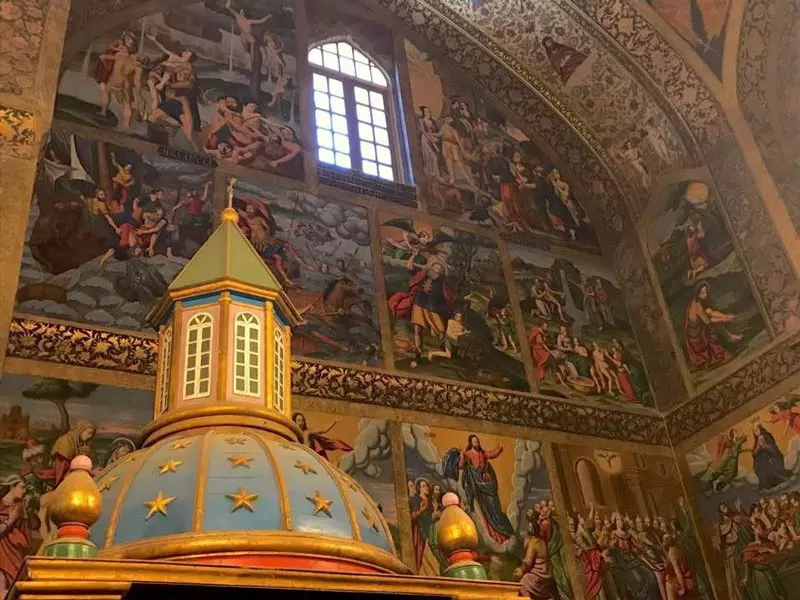
Vank Cathedral Museum
The Vank Cathedral Museum was inaugurated in 1905 and served as both a museum and a library until 1930. Over time, various sections in Vank Cathedral were completed, and different parts such as the prayer hall, the entrance tower, and administrative buildings were added to this complex. At the top of the western entrance door of Vank Cathedral, a tile and turquoise inscription catches the eye, featuring the following text:
“The construction of Vank Amna Perkich Cathedral began in 1655 AD during the reign of King Abbas II, with the leadership of Bishop ‘Philippos’ and the patronage of Archbishop ‘David,’ with the assistance of the benevolent people of Jolfa, and was completed in 1664 AD. The rewards of the prayers performed in this cathedral shall be bestowed upon those who are alive or deceased.”
The construction activities of Armenians in the Jolfa area of Isfahan led to the formation of new architecture in this neighborhood, and among various buildings, Vank Cathedral stands out as the most prominent. Today, this authentic area in Isfahan is known as “New Jolfa Neighborhood,” and tourists and travelers visit Vank Cathedral as one of the most prominent historical landmarks of the city.
Visiting Hours and Address of Vank Cathedral
Vank Cathedral is located in the Jolfa neighborhood, in the heart of Isfahan, and south of the Zayandeh Rud River. Jolfa, now known as New Jolfa, is one of the most beautiful areas of Isfahan. The New Jolfa area is now located in the center of Isfahan, and Vank Cathedral is situated in the northern part of the Jolfa neighborhood. New Jolfa consists of eight districts, bordered by Nazar Street to the north, Shariati Street to the south, Tohid Street to the east, and Hakim Nezami Street to the west.
Depending on your location in Isfahan, you can reach Vank Cathedral from any of the four main streets, but direct access to Church Street is possible from Hakim Nezami Street. As you walk along Church Street, you will see the surrounding walls of the cathedral building. However, driving in the Jolfa area is restricted due to the old structure of the neighborhood, and you can park your car on the surrounding streets.
The Si-o-Se Pol metro station is about two and a half kilometers away from Vank Cathedral, and walking towards the southeast direction from the metro will lead you to the cathedral in approximately 20 minutes. It should be noted that Vank Cathedral is closed on official holidays due to Armenian mourning days, the first day of Norouz, and famous Armenian occasions.
Address of Vank Cathedral: Isfahan, Jolfa Neighborhood, East Nazar Street, Vank Cathedral Alley (View on Map)
Phone: 031-36243471
Visiting Hours: Daily from 8:30 AM to 1:30 PM and 4:00 PM to 6:30 PM
Ticket Price: 15,000 Iranian Rials per person for Iranian visitors and 50,000 Iranian Rials per person for foreign visitors.
Architecture of Vank Cathedral
Vank Cathedral is situated in a compound covering approximately 8,700 square meters, with buildings occupying nearly 4,000 square meters of this area, while the rest comprises the Vank Garden and green spaces within the complex. The exterior façade of the cathedral is clad in brick. While most churches traditionally utilized stone in their construction, Vank Cathedral stands out by using brick instead. Among the brickwork, tiles depicting winged angels can be seen adorning the walls. The entrance street to Vank Cathedral and its inner courtyard are paved with stone.
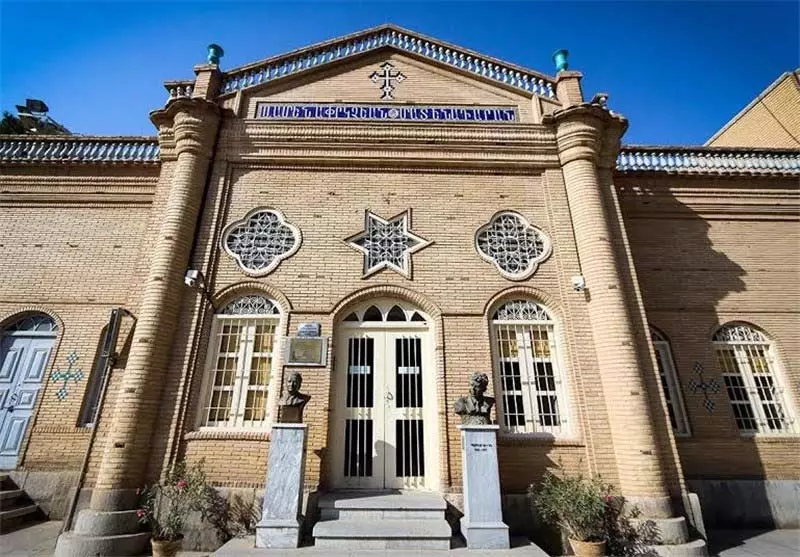
The main entrance for visitors is through a grand wooden door, enhancing the cathedral’s magnificence. Above the doorway, a mural of the interior space catches the eye, adorned with blue and gray tiles. At the top of this mural, the following Armenian inscription is written:
“The monastery of all saviors, a place for monks.”
At the entrance of Vank Cathedral, the bell tower of the church proudly stands. This tower consists of three floors, with a large clock installed on the second floor, weighing 300 kilograms. This clock, donated by Mardiros Gorgi Hordananian in 1931, was built in memory of his deceased brother. Four steel-faced clocks are placed on each face of the tower, with three additional faces located on other sides of the column. The bells in the bell tower ring simultaneously, resonating throughout the Jolfa district. A marble inscription is installed at the entrance of the tower, bearing the following text:
“This tower and its clock were built and donated by Mardiros Gorgi Hordananian in 1931 AD in memory of his deceased brother, who passed away in 1924 AD.”
Today known as the Clock Tower, the bell tower was built 38 years after the construction of the main church by Hovhannes Jamalian. Beneath the bell tower, two graves belonging to an Armenian soldier and an Armenian clergyman can be found. To the right of the bell tower, a blue inscription covered with cross-shaped stones is noticeable. These stones, called Khach Kalim in Armenian, have been brought from other churches in Jolfa to Vank Cathedral.
On both sides of the cathedral entrance, two rooms have been constructed, which were previously used for hosting guests but have now been converted into a shop and a guard room. Another architectural feature of Vank Cathedral is its domes.
Vank Cathedral has two small and large domes, with the small dome situated above the gathering hall and the large dome erected over the altar of the church. Upon entering the cathedral from the west, square-shaped columns with high vaulted arches are prominent. The cathedral’s domes are built upon these columns and vaulted arches.
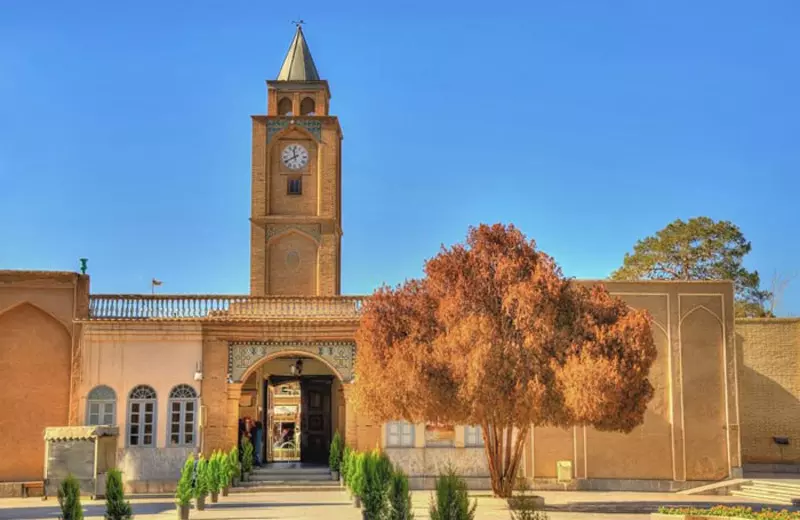
The architectural style of the large dome bears a striking resemblance to the domes of mosques, while traditional church domes are conical in shape. Given the building’s construction during the Safavid period, its dome drew inspiration from mosque architecture of that era. The outer shell of the dome is constructed from brick, while the inner shell is painted with lapis lazuli color. Around this large circular dome, eight windows are embedded. Within these windows, one can observe sculptures and paintings.
The paintings on the dome of Vank Cathedral are among its most beautiful attractions, offering a delightful experience for tourists. Images depicting the creation of Adam and Eve, the story of Adam eating the forbidden fruit, and the tale of Cain and Abel adorn the lapis lazuli surface of the large dome.
On the roof of the church and near the small dome, another bell is placed within a square-shaped structure supported by three-meter columns. These columns are connected at the top by wooden beams and feature pointed arches between them.
Beautiful Paintings Inside Vank Cathedral
Among the most beautiful aspects of architecture in Vank Cathedral are the paintings inside the main building. The walls of the cathedral’s hall are covered with plasterwork, adorned with magnificent paintings throughout. The interior architecture of Vank Cathedral, with its goldwork, engraving, and wall paintings, stands out not only in Iran but also globally as a distinguished church.
The paintings in Vank Cathedral can be divided into two categories. The first category consists of paintings on canvas, fabric, and boards hung in the sanctuary and other areas. The second category includes wall paintings and painted stone pieces. One of the paintings in Vank Cathedral depicts the seven levels of heaven, paradise, and hell, counted among the most beautiful artworks in the cathedral.
Among the most captivating features of Vank Cathedral that attract visitors’ attention are the sculptures installed in its courtyard. These sculptures are half-body statues depicting Armenian luminaries. To the right of the museum’s entrance stands the statue of Mesrop Mashtots, the inventor of the Armenian alphabet, while on the left stands the statue of Khrimian Hayrik, the supreme patriarch of the Armenians. Other famous statues in Vank Cathedral include those of renowned Armenian poets from the 20th century, installed on both sides of the library entrance. One of them belongs to Baruir Sevag, a renowned Armenian poet. These statues, along with the museum entrance sculptures, are the works of the prominent Armenian artist Zaven Aivazian, crafted during his time in Iran before migrating to Italy, and are considered among the masterpieces of this artist. Additionally, numerous tombs of prominent Armenians can be found within the courtyard of Vank Cathedral.
Sculpture of Khachatur Kesaratsi
In the square facing Vank Cathedral, a full-length statue catches the eye, depicting a figure wearing a robe with one hand resting on several books and the other hand holding a small tool. This sculpture represents Khachatur Kesaratsi, the supreme patriarch of the Armenians from 1620 to 1646, who was also the founder of the first printing press in Iran. He is considered one of the most powerful and influential Armenian leaders, providing valuable services to Armenians worldwide.
Sections of Vank Cathedral
Vank Cathedral has evolved significantly over time, with many sections added to it. The evolution of different sections of Vank Cathedral over time is evident, although some sections have been lost, many parts have been added, renovated, and equipped over the years. This church includes sections such as a museum, library, monastery, bell house, clock tower, printing press, and administrative offices. In this section, we introduce the various parts of the Vank Cathedral compound.
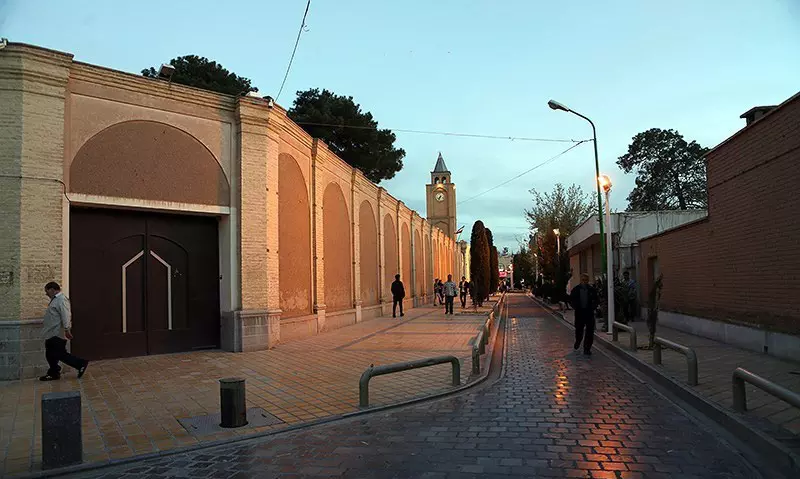
Vank Cathedral Museum
In all Isfahan churches, a significant portion is dedicated to preserving prominent historical artifacts. In fact, the function of churches throughout history has not been solely religious, and preserving and disseminating Armenian culture to future generations ranks among the most important tasks of churches. Vank Cathedral also houses one of the most prominent Armenian museums.
One of the most outstanding pieces in the Vank Museum is the hair strand of an 18-year-old girl with a sentence from the Torah written on it. Initially, the Vank Cathedral Museum consisted of only a few simple rooms built about a hundred years ago on the north side of Vank Cathedral by Tadeos Hunanian. However, today it has become a large and comprehensive museum. The museum preserves prominent historical paintings, valuable handwritten books, and ancient artifacts that were previously stored in an abandoned warehouse in the church.
One of the most famous artifacts in this museum is the hair strand belonging to an 18-year-old girl with a sentence from the Torah inscribed on it with a diamond pen. Vahram Hakobyan, an Armenian artist, created this piece in 1974 AD, and it was donated to the Vank Museum in 1975 AD. Visitors can observe the inscription on the hair strand using a microscope. The inscription on the hair strand is as follows:
“To understand wisdom and justice, and to comprehend the words of understanding.”
The Vank Cathedral Museum is one of the most important cultural centers for Armenians in Iran and the world, and numerous tourists visit annually to see the artifacts housed in this museum.
Vank Cathedral Library
A significant portion of the cultural heritage of the Armenians in Isfahan is preserved in the Vank Cathedral Library. This library is located in the northern part of Vank Cathedral, adjacent to the museum. Some of the documents and historical books in this library date back more than 400 years, preserved in the archive section, with public access restricted. The Amenaprkich Library is one of the most important cultural centers for Armenians worldwide.
In addition to historical and cultural Armenian books, other works in Persian, English, and other languages are also housed in this library. The total collection exceeds 30,000 volumes. Armenians in Isfahan and other parts of Iran have adequate access to the books in this center, but non-Armenians require special conditions and a letter of introduction to use the library facilities.
The Vank Cathedral Library was established in 1884 by Hovhannes Sorian (the then patriarch). The purpose of establishing this center was to preserve valuable Armenian books that many Armenians had brought with them since migration, and over time, these books gained significant value. As time passed, the number of books increased.
Vank Cathedral Printing Press
In 1630 AD, Khachatur Kesaratsi, as the Armenian patriarch of Isfahan, decided to establish a modern printing press in Vank Cathedral. The reason for this decision was his visit to Poland and becoming familiar with the printing industry there. Eight years later, the first book was printed in the Vank Cathedral printing press, which was a version of the Psalms. Printing this edition took one year and five months, and all the clergy of the church were involved in this task. This book is considered the first printed book in Iran.
At that time, the printing press tools and equipment were handmade and simple, which Khachatur Kesaratsi and his companions had made based on their experience from traveling to Europe. Over the next four years, four other books were printed in this press, all focusing on educating and disseminating Armenian culture. Over time, the printing became more regular and beautiful, and in the printing of the last book, illustrations and paintings were also used for book decoration.
The first printing press in Iran was founded in Vank Cathedral, and the first printed book in Iran was also published in this church. After that, the printing press flourished for some time until, unfortunately, there was much opposition to the activities of the Vank Cathedral printing press, which ultimately led to its burning and destruction. Currently, the famous Vank Cathedral printing press machine and samples of the books printed in the early years are kept in the Vank Museum.
Vank Cathedral Prayer Hall
In Vank Cathedral, a building for the prayer hall has been constructed, which is parallelogram-shaped and consists of two parts. The first part is the vestibule, and the second part, located under the dome, is used for conducting religious ceremonies on special occasions.
Colorful tiles adorn all the walls of the prayer hall building. Images from the holy book are inscribed on the top of the walls up to the dome’s interior, and the inner part of the dome is covered with decorative paintings and tiles; however, only a brick facade is visible on the exterior surface of the dome.

Memorial Building for Armenian Genocide Martyrs
In the courtyard of Vank Cathedral, in the northwest part of the church, a structure with distinctive architecture catches the eye. This building was constructed in 1975 AD, on the sixtieth anniversary of the Armenian genocide by the Ottomans. The building is square-shaped and consists of four columns connected at the top. The engineer and designer, Albert Ajamian, created this work with the aim of cultural preservation for future generations of Armenian immigrants and to keep the memory of the victims alive. Every year, on April 24th, a memorial ceremony is held at this location, attended by Armenians from Isfahan.
Administrative Building
Today, Vank Cathedral is also the most important social center for Armenians in Isfahan. Although in the past, this church served a broader range, and sometimes even Armenians from India visited Vank Cathedral for administrative purposes, today it only provides services to the southern regions of Iran.
All administrative matters related to marriage, death, and birth, such as document issuance and legal complaints by Armenians, are handled in the administrative section of Vank Cathedral. The administrative building of Vank Cathedral is located in the southern part of this complex and was built during the reign of Naser al-Din Shah Qajar.
Frequently Asked Questions
Where is Vank Cathedral located?
Vank Cathedral is located in the Jolfa neighborhood in the center of Isfahan and on the south bank of the Zayandeh River. Jolfa, now known as New Jolfa, is one of the most beautiful areas of Isfahan.
How can we get to Vank Cathedral?
Depending on your location in Isfahan, you can reach Vank Cathedral from all the surrounding streets of the Jolfa neighborhood, but direct access to Church Street is possible from Hakim Nezami Street. As you walk along Church Street, you will see the surrounding walls of the church building.
Is it possible for the public to visit Vank Cathedral?
Visiting Vank Cathedral is free for the public, and enthusiasts can visit Vank Cathedral every day from 8:30 to 13:30 and 16:00 to 18:30.
How much is the ticket price for Vank Cathedral?
The ticket price is 15,000 Iranian rials per person for Iranian visitors and 50,000 Iranian rials per person for foreign visitors.
vank cathedral photos



